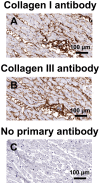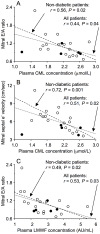Diastolic dysfunction of aging is independent of myocardial structure but associated with plasma advanced glycation end-product levels
- PMID: 23189164
- PMCID: PMC3506639
- DOI: 10.1371/journal.pone.0049813
Diastolic dysfunction of aging is independent of myocardial structure but associated with plasma advanced glycation end-product levels
Abstract
Background: Heart failure is associated with abnormalities of myocardial structure, and plasma levels of the advanced glycation end-product (AGE) N(ε)-(carboxymethyl)lysine (CML) correlate with the severity and prognosis of heart failure. Aging is associated with diastolic dysfunction and increased risk of heart failure, and we investigated the hypothesis that diastolic dysfunction of aging humans is associated with altered myocardial structure and plasma AGE levels.
Methods: We performed histological analysis of non-ischemic left ventricular myocardial biopsies and measured plasma levels of the AGEs CML and low molecular weight fluorophores (LMWFs) in 26 men undergoing coronary artery bypass graft surgery who had transthoracic echocardiography before surgery. None had previous cardiac surgery, myocardial infarction, atrial fibrillation, or heart failure.
Results: The patients were aged 43-78 years and increasing age was associated with echocardiographic indices of diastolic dysfunction, with higher mitral Doppler flow velocity A wave (r = 0.50, P = 0.02), lower mitral E/A wave ratio (r = 0.64, P = 0.001), longer mitral valve deceleration time (r = 0.42, P = 0.03) and lower early diastolic peak velocity of the mitral septal annulus, e' (r = 0.55, P = 0.008). However, neither mitral E/A ratio nor mitral septal e' was correlated with myocardial total, interstitial or perivascular fibrosis (picrosirius red), immunostaining for collagens I and III, CML, and receptor for AGEs (RAGE), cardiomyocyte width, capillary length density, diffusion radius or arteriolar dimensions. Plasma AGE levels were not associated with age. However, plasma CML levels were associated with E/A ratio (r = 0.44, P = 0.04) and e' (r = 0.51, P = 0.02) and LMWF levels were associated with E/A ratio (r = 0.49, P = 0.02). Moreover, the mitral E/A ratio remained correlated with plasma LMWF levels in all patients (P = 0.04) and the mitral septal e' remained correlated with plasma CML levels in non-diabetic patients (P = 0.007) when age was a covariate.
Conclusions: Diastolic dysfunction of aging was independent of myocardial structure but was associated with plasma AGE levels.
Conflict of interest statement
Figures










Similar articles
-
Impact of type 2 diabetes and the metabolic syndrome on myocardial structure and microvasculature of men with coronary artery disease.Cardiovasc Diabetol. 2011 Sep 19;10:80. doi: 10.1186/1475-2840-10-80. Cardiovasc Diabetol. 2011. PMID: 21929744 Free PMC article.
-
Serum levels of advanced glycation end products are associated with left ventricular diastolic function in patients with type 1 diabetes.Diabetes Care. 1999 Jul;22(7):1186-90. doi: 10.2337/diacare.22.7.1186. Diabetes Care. 1999. PMID: 10388987
-
Tissue Doppler imaging in patients with advanced heart failure: relation to functional class and prognosis.J Heart Lung Transplant. 2006 Feb;25(2):214-8. doi: 10.1016/j.healun.2005.09.002. J Heart Lung Transplant. 2006. PMID: 16446223
-
Clinical aspects of left ventricular diastolic function assessed by Doppler echocardiography following acute myocardial infarction.Dan Med Bull. 2001 Nov;48(4):199-210. Dan Med Bull. 2001. PMID: 11767125 Review.
-
[Evaluation of left ventricular diastolic function using Doppler echocardiography].Med Pregl. 1999 Jan-Feb;52(1-2):13-8. Med Pregl. 1999. PMID: 10352498 Review. Croatian.
Cited by
-
Genetic and environmental determinants of diastolic heart function.Nat Cardiovasc Res. 2022 Apr;1(4):361-371. doi: 10.1038/s44161-022-00048-2. Epub 2022 Apr 13. Nat Cardiovasc Res. 2022. PMID: 35479509 Free PMC article.
-
Extracellular matrix roles in cardiorenal fibrosis: Potential therapeutic targets for CVD and CKD in the elderly.Pharmacol Ther. 2019 Jan;193:99-120. doi: 10.1016/j.pharmthera.2018.08.014. Epub 2018 Aug 25. Pharmacol Ther. 2019. PMID: 30149103 Free PMC article. Review.
-
The impact of aging on cardiac extracellular matrix.Geroscience. 2017 Feb;39(1):7-18. doi: 10.1007/s11357-017-9959-9. Epub 2017 Jan 17. Geroscience. 2017. PMID: 28299638 Free PMC article. Review.
-
Obesity is associated with lower coronary microvascular density.PLoS One. 2013 Nov 29;8(11):e81798. doi: 10.1371/journal.pone.0081798. eCollection 2013. PLoS One. 2013. PMID: 24312359 Free PMC article.
-
Activated Protein C Strengthens Cardiac Tolerance to Ischemic Insults in Aging.Circ Res. 2022 Jan 21;130(2):252-272. doi: 10.1161/CIRCRESAHA.121.319044. Epub 2021 Dec 21. Circ Res. 2022. PMID: 34930019 Free PMC article.
References
-
- Redfield MM, Jacobsen SJ, Borlaug BA, Rodeheffer RJ, Kass DA (2005) Age- and gender-related ventricular-vascular stiffening: a community-based study. Circulation 112: 2254–2262. - PubMed
-
- Lakatta EG, Levy D (2003) Arterial and cardiac aging: major shareholders in cardiovascular disease enterprises. Part I: Aging arteries: A “set up” for vascular disease. Circulation 107: 139–146. - PubMed
-
- Lakatta EG, Levy D (2003) Arterial and cardiac aging: major shareholders in cardiovascular disease enterprises: Part II: the aging heart in health: links to heart disease. Circulation 107: 346–354. - PubMed
-
- Unverferth DV, Fetters JK, Unverferth BJ, Leier CV, Magorien RD, et al. (1983) Human myocardial histologic characteristics in congestive heart failure. Circulation 68: 1194–1200. - PubMed
Publication types
MeSH terms
Substances
LinkOut - more resources
Full Text Sources
Medical

